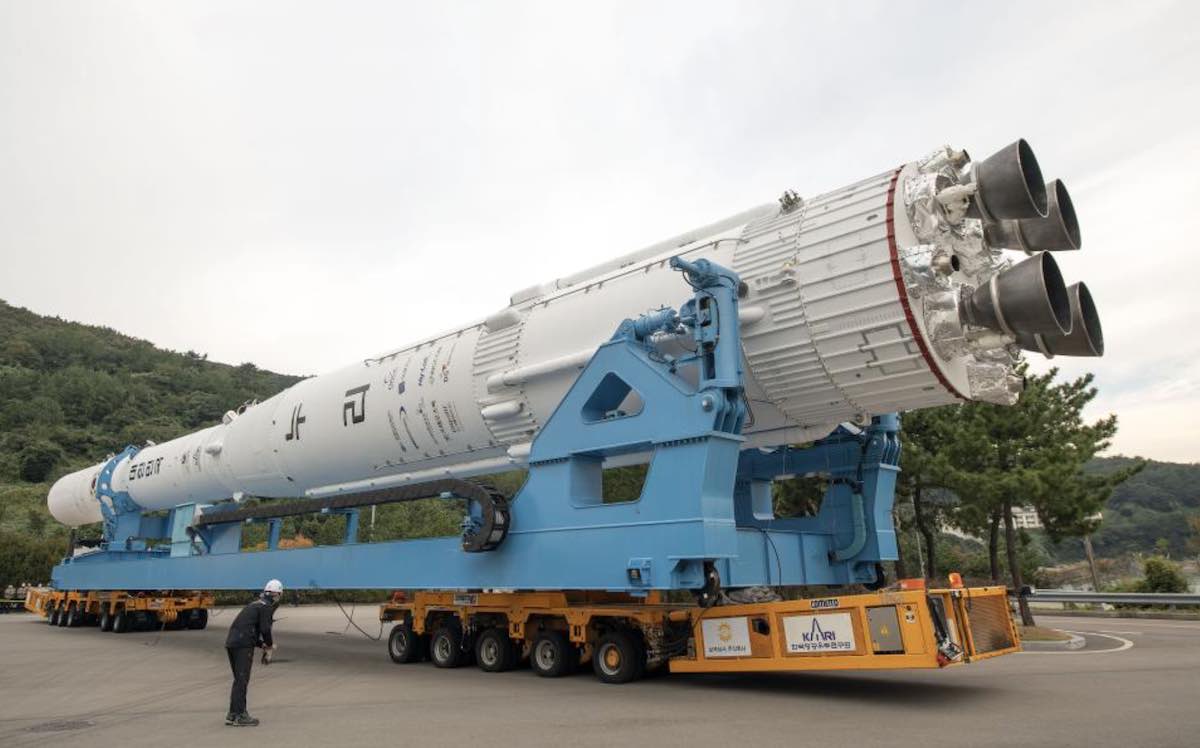Space News & Blog Articles
Watch live: South Korean satellite launcher set for first test flight
EDITOR’S NOTE: South Korea’s science ministry will stream the Nuri rocket launch live beginning at 1:30 a.m. EDT (0530 GMT) Thursday, Oct. 21.
South Korea’s new three-stage, liquid-fueled Nuri launcher is scheduled to blast off Thursday on the country’s first attempt to place an object into orbit with an entirely homegrown rocket.
The launch Thursday is the culmination of a nearly 12-year, $1.7 billion development program to give South Korea a domestic satellite launch capability. South Korea’s space agency, the Korea Aerospace Research Institute, led the effort to design, build, and test the Nuri rocket.
Liftoff is scheduled for 3 a.m. EDT (0700 GMT) from the Naro Space Center, a spaceport around 300 miles (500 kilometers) south of Seoul.
“Nuri is our country’s own space launch vehicle that has been developed through the blood, sweat, and tears of many researchers and industrial parties since 2010, and I believe its launch this October will mark a milestone in the history of our space development,” said Lim Hye-sook, South Korea’s science minister, in a statement.
“Since it is an important period ahead of the launch, the government will also provide active support so that researchers can do their best and concentrate on research and development with a calm mind until the last moment,” she said.
 South Korea’s Nuri rocket on its launch pad Wednesday at the Naro Space Center. Credit: KARI
South Korea’s Nuri rocket on its launch pad Wednesday at the Naro Space Center. Credit: KARI
The Nuri rocket, also known as the KSLV 2, will aim to deliver a satellite mock-up to a polar orbit around 435 miles (700 kilometers) above Earth after launch Thursday. KARI officials have given the test launch just a 30% chance of success, according to the Korea Herald, the country’s largest English-language newspaper.
Ground crews transferred the rocket from its assembly hangar to its launch pad Wednesday. The nearly 155-foot-tall (47.2-meter) rocket was raised vertical in preparation for the multi-hour countdown.
Before liftoff, the South Korean launch team will load kerosene and liquid oxygen propellants into all three stages of the Nuri rocket.
Four KRE-075 engines, developed by the South Korean company Hanwha Aerospace, will flash to life in the final moments of the countdown. The liquid-fueled engines will power up to full throttle, generating 586,000 pounds of thrust to push the launcher into the sky.
The rocket’s KRE-075 engines each use a gas generator to drive a pump feeding propellant into the thrust chamber. SpaceX’s Merlin engine, which power the Falcon 9 rocket, use a similar design.
The Nuri rocket’s second stage has a single KRE-075 engine with a vacuum expansion nozzle. The launcher’s third stage, which fires to inject payloads into orbit, is powered by a smaller engine producing about 15,000 pounds of thrust.
Heading south from the Naro Space Center, the Nuri rocket will exceed the speed of sound in less than a minute before climbing through the stratosphere. Here is an overview of the launch sequence:
• T+00:55: Mach 1
• T+02:07: Stage 1 Separation
• T+03:53: Fairing Separation
• T+04:34: Stage 2 Separation
• T+13:18: Stage 3 Shutdown
• T+16:07: Payload Separation
The launch of South Korea’s first Nuri rocket comes nearly nine years after the only successful launch of the Naro 1 booster. South Korea launched three Naro 1 rockets from the Naro Space Center, but the first two flights in 2009 and 2010 failed shortly after liftoff.
The third Naro 1 mission Jan. 30, 2013, successfully deployed a small South Korean technology demonstration satellite into orbit, making South Korea the 11th country to launch its own satellite into orbit, but the feat was not accomplished without international help.
 The Naro Space Center is located in South Jeolla province about 300 miles south of Seoul. Credit: Google / Spaceflight Now
The Naro Space Center is located in South Jeolla province about 300 miles south of Seoul. Credit: Google / Spaceflight Now
Russia’s space contractor Khrunichev developed the Naro 1’s first stage, and the booster’s kerosene-fueled RD-151 main engine was built by NPO Energomash, another Russian company.
Korea Aerospace Industries led the South Korean industrial team responsible for developing the Nuri rocket.
South Korea’s space industry has grown in the last decade with the advancement of the country’s domestic satellite manufacturing base. The first two geostationary satellites built in South Korea launched in 2018 and 2020 on weather monitoring and oceanography missions.
The Korea Pathfinder Lunar Orbiter is scheduled to launch in 2022 on a SpaceX Falcon 9 rocket. The spacecraft is being manufactured in South Korea, and will carry a payload of Korean and U.S. science instruments to study the moon.
KARI also has a roadmap to develop a bigger satellite launcher after debuting the Nuri rocket.
 South Korea’s Nuri rocket rolls out to its launch pad Wednesday. Credit: KARI
South Korea’s Nuri rocket rolls out to its launch pad Wednesday. Credit: KARI
The Nuri, which means “world” in Korean, is designed to place a payload of up to 3,300 pounds (1,500 kilograms) into an orbit more than 372 miles (600 kilometers) in altitude.
South Korean officials plan to launch the second Nuri rocket next May. That mission will be the first Nuri flight to carry a real satellite into orbit.
This email address is being protected from spambots. You need JavaScript enabled to view it. the author.
Follow Stephen Clark on Twitter: @StephenClark1.
When you subscribe to the SpaceZE News Feed, we will send you an e-mail when there are new updates on the site so you wouldn't miss them.

